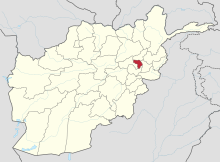Purdil Khan
Purdil Khan (died 1930) was a Saqqawist who served Habibullāh Kalakāni during the Afghan civil war of 1928-29, and briefly became the leader of the movement during a rebellion in July 1930.
Personal life[]
Purdil was the uncle of Habibullāh Kalakāni.[1]
Role in the civil war of 1928-1929[]
Purdil was appointed field marshal of the Saqqawist Afghan army in January 1929, following the capture of Kabul.[2] By 24 March, Purdil had become minister of defense.[3]
After the Saqqawist capture of Kandahar, Purdil pleaded to Kalakani that Ali Ahmad Khan be spared, but this was refused.[4]
Purdil took command in the following battles:[3]
- Battle of Maydan, 24 March 1929. Saqqawist victory.[3]
- Battle of Shaykhabad, 9 April 1929. anti-Saqqawist victory.[5]
- Battle of Ghazni, 28 April 1929. Saqqawist victory.[6]
- Siege of Kalat, 19–23 May 1929. Saqqawist victory.[7]
- Capture of Kandahar, 31 May 1929. Saqqawist victory.[8]
- Fall of Kabul, 9–13 October 1929. anti-Saqqawist victory, end of the civil war.[9]
Kuhistan rebellion and death[]
| Kuhistan rebellion (July 1930) | |||||||
|---|---|---|---|---|---|---|---|
 A map of modern-day Kapisa Province, where the fighting took place. | |||||||
| |||||||
| Belligerents | |||||||
| Kingdom of Afghanistan | Saqqawist rebels | ||||||
| Commanders and leaders | |||||||
| Mohammed Nadir Shah | Purdil Khan † | ||||||
| Casualties and losses | |||||||
| Unknown | 3000 captured | ||||||
After the end of the civil war, Purdil organized a new revolt.[10] In July 1930,[1] Saqqawists fought against state forces in modern-day Kohistan District, Kapisa Province.[11][1] The rebellion was crushed within a week.[11] After the rebellion was suppressed, 3000 of the rebels were captured and 11 of the ringleaders were executed,[1] while the rest were allowed to go home and "follow some honest pursuit".[11] Purdil was killed during the fighting.[12]
References[]
- ^ a b c d Gladstone, Soloman W. E. (2018-03-02). A History of Afghanistan Vol II. Creative Media Partners, LLC. p. 322. ISBN 9781378970881.
- ^ Muḥammad, Fayz̤; McChesney, R. D. (1999). Kabul under siege: Fayz Muhammad's account of the 1929 Uprising. Markus Wiener Publishers. p. 57. ISBN 9781558761544.
- ^ a b c Muḥammad, Fayz̤; McChesney, R. D. (1999). Kabul under siege: Fayz Muhammad's account of the 1929 Uprising. Markus Wiener Publishers. p. 68. ISBN 9781558761544.
- ^ Muḥammad, Fayz̤; McChesney, R. D. (1999). Kabul under siege: Fayz Muhammad's account of the 1929 Uprising. Markus Wiener Publishers. p. 84. ISBN 9781558761544.
- ^ Muḥammad, Fayz̤; McChesney, R. D. (1999). Kabul under siege: Fayz Muhammad's account of the 1929 Uprising. Markus Wiener Publishers. p. 71. ISBN 9781558761544.
- ^ Muḥammad, Fayz̤; McChesney, R. D. (1999). Kabul under siege: Fayz Muhammad's account of the 1929 Uprising. Markus Wiener Publishers. p. 75. ISBN 9781558761544.
- ^ Muḥammad, Fayz̤; McChesney, R. D. (1999). Kabul under siege: Fayz Muhammad's account of the 1929 Uprising. Markus Wiener Publishers. p. 82. ISBN 9781558761544.
- ^ Muḥammad, Fayz̤; McChesney, R. D. (1999). Kabul under siege: Fayz Muhammad's account of the 1929 Uprising. Markus Wiener Publishers. p. 219. ISBN 9781558761544.
- ^ Muḥammad, Fayz̤; McChesney, R. D. (1999). Kabul under siege: Fayz Muhammad's account of the 1929 Uprising. Markus Wiener Publishers. p. 274. ISBN 9781558761544.
- ^ Emadi, Hafizullah (2005). Culture and Customs of Afghanistan. Greenwood Publishing Group. p. 35. ISBN 9780313330896.
- ^ a b c Ali, Mohammed (1933). Progressive Afghanistan. Punjab Educational Electric Press. pp. 179, 180.
- ^ Yunas, S. Fida (2002). Afghanistan: The Peshawar Sardars' branch of Barakzais. p. 78.
- 1930 deaths
- 20th-century Afghan military personnel
- Afghan rebels